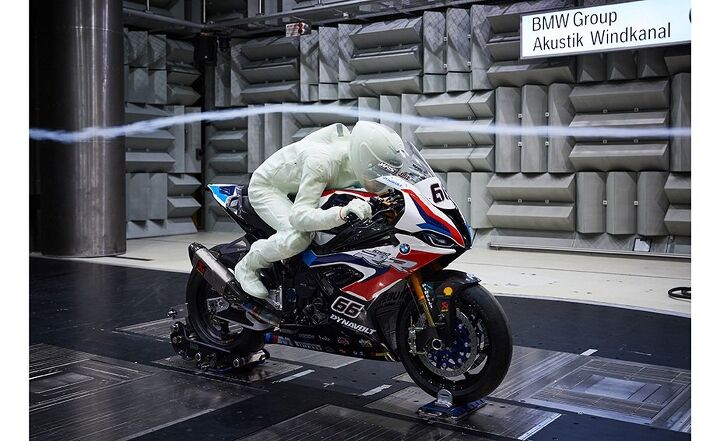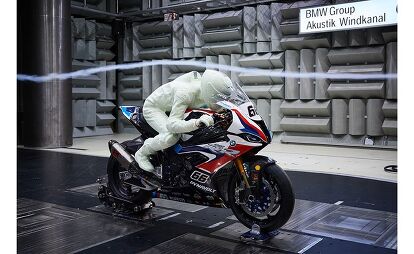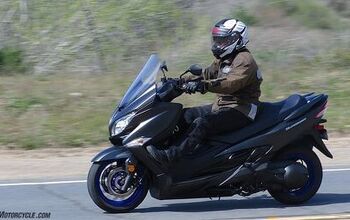BMW 3D Scanned Its Riders To Work On Aerodynamics During the Pandemic

With the World Superbike championship set to resume again this weekend in Jerez, after a long Coronavirus-induced break since the season opener at Philip Island in February, BMW felt it necessary to tell everyone how it was spending its time in lockdown – and it’s pretty fascinating.
While lockdown meant racing has stopped, development of the S1000RR World Superbike challenger has not. Specifically in the area of aerodynamics. Cutting through the air as efficiently as possible is a big deal when racing at the highest levels, and while it’s easy enough to place an S1000RR in the wind tunnel, doing so without a rider aboard is pointless. But what do you do when your riders are in different countries, unable to travel to Munich because of the restrictions imposed by the pandemic?
You build life-size 3D models of your riders, of course. Turns out Eugene Laverty just happened to be at BMW HQ in Germany shortly before the lockdown started. These kinds of things are not unusual, as the riders visit the factories to meet the team and get comfortable on the motorcycle. This time, BMW also used the opportunity to take detailed 3D scans of Laverty – fully suited – while in the tucked position.
The precision of these measurements means every individual glove finger, every contour of the helmet, every seam in the leathers, and every crease that could affect the aerodynamic drag and airflow was measured. “Based on the data from the 3D scan, we created a plastic model made of two halves. It took about a week to get all the details right, however our 3D Eugene was then ready for action,” said BMW Motorrad Motorsport Director Marc Bongers. Considering the impending pandemic, and the havoc it would cause on the schedule, the timing couldn’t have been better.
The plastic version of Laverty has now been used over 50 times, as he’s sat patiently atop the S1000RR. BMW’s wind tunnel is equipped with a 2,600 hp electric motor, able to recreate speeds of nearly 160 mph. “Using a 3D model like this allows us to work more efficiently on development of our RR,” explains Bongers. “While a real rider must travel to get here, the plastic version is available at any time for testing in the wind tunnel. This means that we can evaluate and implement updates even faster.”
As for the 3D model itself, the real Eugene Laverty joked, “He’s just a few shades paler than my Irish complexion.”
While not a track that sees high top speed, the Jerez circuit will be a chance to see what advantages the aero improvements have provided to both Laverty and his teammate Tom Sykes (who wasn’t available for the initial 3D scan, but has since also been recreated in plastic). Of course, all the other teams have also been working on their machines during the lockdown, so any expectations of significant gains is unrealistic. Still, having the capabilities to 3D-scan a rider and recreate them for these purposes is amazing, and a testament to how creative teams will get to look for an advantage.
Source: BMW Motorrad Motorsport
Become a Motorcycle.com insider. Get the latest motorcycle news first by subscribing to our newsletter here.

Troy's been riding motorcycles and writing about them since 2006, getting his start at Rider Magazine. From there, he moved to Sport Rider Magazine before finally landing at Motorcycle.com in 2011. A lifelong gearhead who didn't fully immerse himself in motorcycles until his teenage years, Troy's interests have always been in technology, performance, and going fast. Naturally, racing was the perfect avenue to combine all three. Troy has been racing nearly as long as he's been riding and has competed at the AMA national level. He's also won multiple club races throughout the country, culminating in a Utah Sport Bike Association championship in 2011. He has been invited as a guest instructor for the Yamaha Champions Riding School, and when he's not out riding, he's either wrenching on bikes or watching MotoGP.
More by Troy Siahaan













































Comments
Join the conversation
How do they factor the affect of the rider weight?
"having the capabilities to 3D-scan a rider and recreate them for these purposes is amazing" -- and expensive, and useless.. when a run of the mill dummy dressed in a leather suit (friction coefficient identical to the rider's, unlike plastic) would have worked better. Fancy bad ideas trump sound engineering every single day in the corporate world.